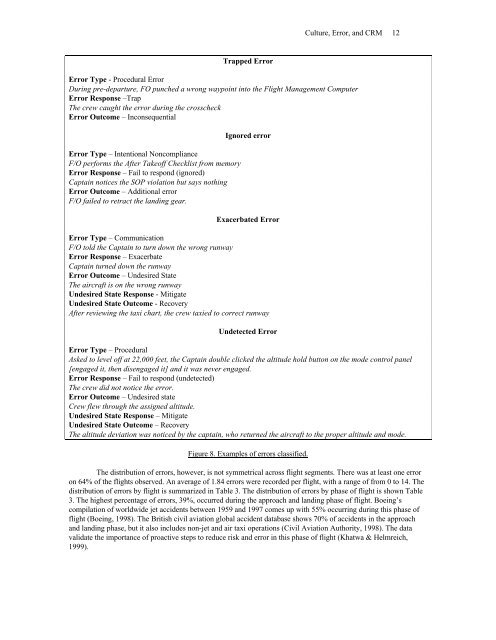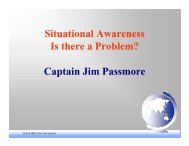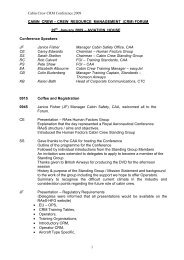Culture, Error, and Crew Resource Management - Human Factors ...
Culture, Error, and Crew Resource Management - Human Factors ...
Culture, Error, and Crew Resource Management - Human Factors ...
You also want an ePaper? Increase the reach of your titles
YUMPU automatically turns print PDFs into web optimized ePapers that Google loves.
Trapped <strong>Error</strong><br />
<strong>Culture</strong>, <strong>Error</strong>, <strong>and</strong> CRM 12<br />
<strong>Error</strong> Type - Procedural <strong>Error</strong><br />
During pre-departure, FO punched a wrong waypoint into the Flight <strong>Management</strong> Computer<br />
<strong>Error</strong> Response –Trap<br />
The crew caught the error during the crosscheck<br />
<strong>Error</strong> Outcome – Inconsequential<br />
<strong>Error</strong> Type – Intentional Noncompliance<br />
F/O performs the After Takeoff Checklist from memory<br />
<strong>Error</strong> Response – Fail to respond (ignored)<br />
Captain notices the SOP violation but says nothing<br />
<strong>Error</strong> Outcome – Additional error<br />
F/O failed to retract the l<strong>and</strong>ing gear.<br />
Ignored error<br />
Exacerbated <strong>Error</strong><br />
<strong>Error</strong> Type – Communication<br />
F/O told the Captain to turn down the wrong runway<br />
<strong>Error</strong> Response – Exacerbate<br />
Captain turned down the runway<br />
<strong>Error</strong> Outcome – Undesired State<br />
The aircraft is on the wrong runway<br />
Undesired State Response - Mitigate<br />
Undesired State Outcome - Recovery<br />
After reviewing the taxi chart, the crew taxied to correct runway<br />
Undetected <strong>Error</strong><br />
<strong>Error</strong> Type – Procedural<br />
Asked to level off at 22,000 feet, the Captain double clicked the altitude hold button on the mode control panel<br />
[engaged it, then disengaged it] <strong>and</strong> it was never engaged.<br />
<strong>Error</strong> Response – Fail to respond (undetected)<br />
The crew did not notice the error.<br />
<strong>Error</strong> Outcome – Undesired state<br />
<strong>Crew</strong> flew through the assigned altitude.<br />
Undesired State Response – Mitigate<br />
Undesired State Outcome – Recovery<br />
The altitude deviation was noticed by the captain, who returned the aircraft to the proper altitude <strong>and</strong> mode.<br />
Figure 8. Examples of errors classified.<br />
The distribution of errors, however, is not symmetrical across flight segments. There was at least one error<br />
on 64% of the flights observed. An average of 1.84 errors were recorded per flight, with a range of from 0 to 14. The<br />
distribution of errors by flight is summarized in Table 3. The distribution of errors by phase of flight is shown Table<br />
3. The highest percentage of errors, 39%, occurred during the approach <strong>and</strong> l<strong>and</strong>ing phase of flight. Boeing’s<br />
compilation of worldwide jet accidents between 1959 <strong>and</strong> 1997 comes up with 55% occurring during this phase of<br />
flight (Boeing, 1998). The British civil aviation global accident database shows 70% of accidents in the approach<br />
<strong>and</strong> l<strong>and</strong>ing phase, but it also includes non-jet <strong>and</strong> air taxi operations (Civil Aviation Authority, 1998). The data<br />
validate the importance of proactive steps to reduce risk <strong>and</strong> error in this phase of flight (Khatwa & Helmreich,<br />
1999).




